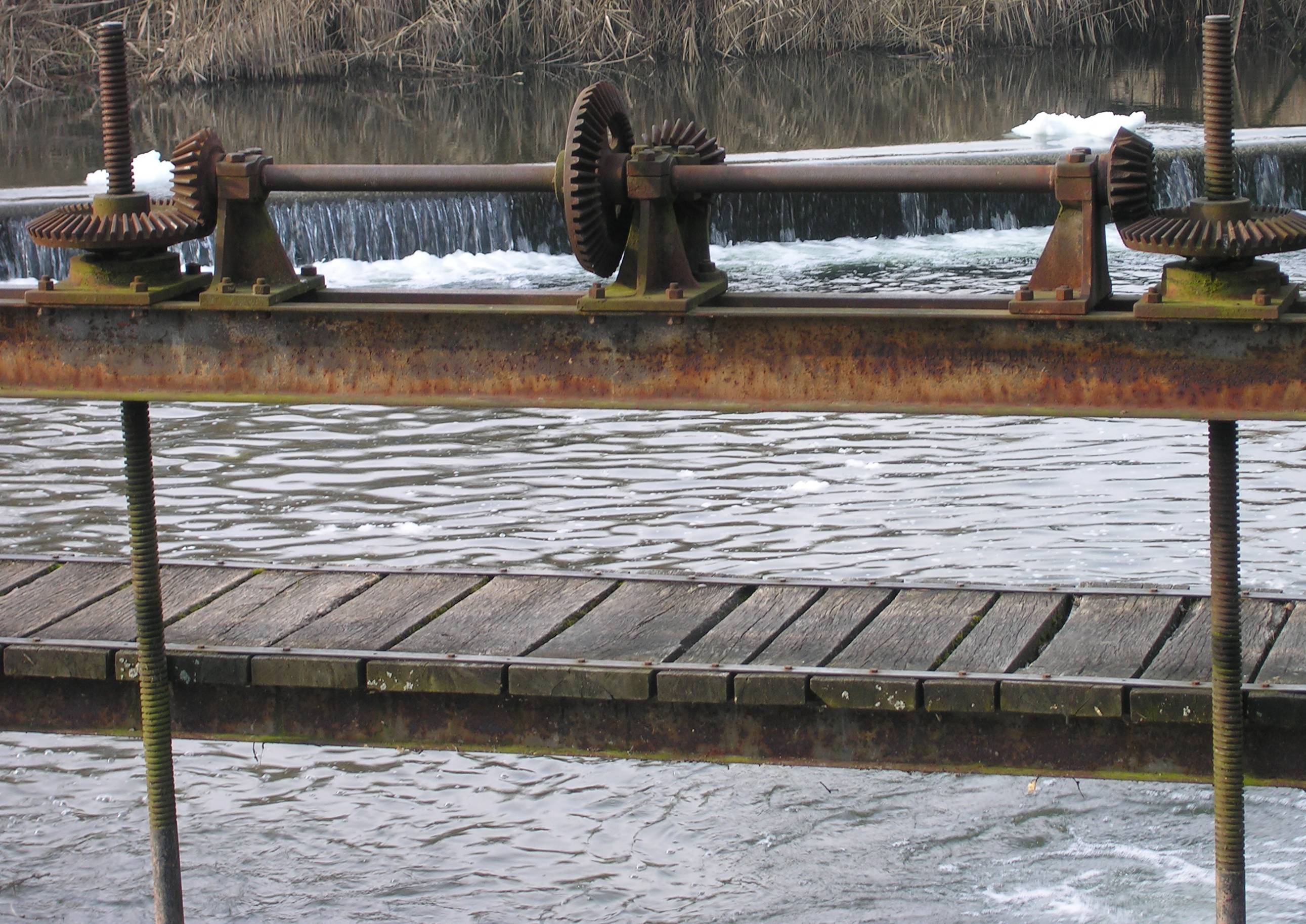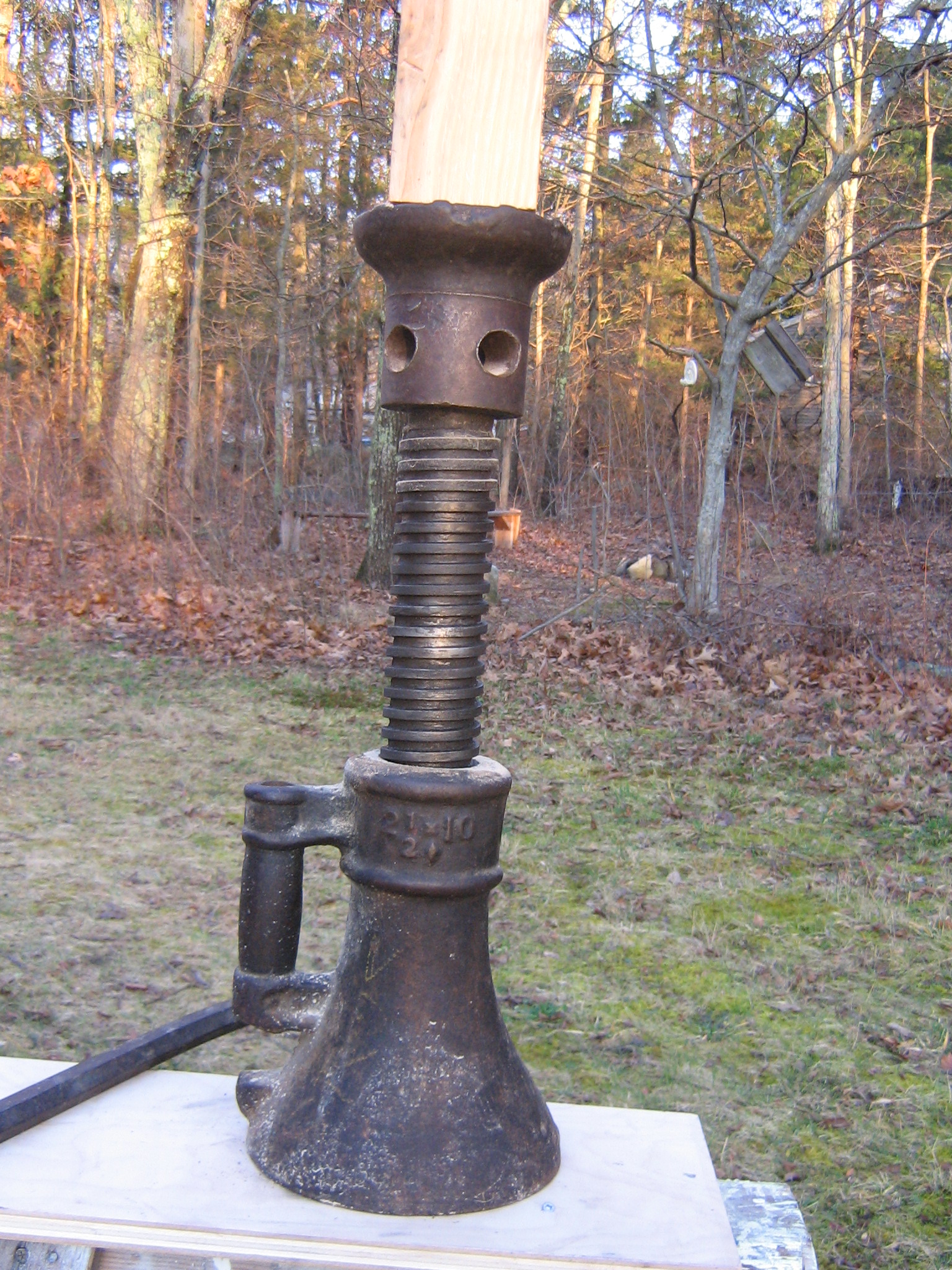|
Square Thread Form
The square thread form is a common screw thread profile, used in high load applications such as leadscrews and jackscrews. It gets its name from the square cross-section of the thread.Bhandari, p. 203. It is the lowest friction and most efficient thread form, but it is difficult to fabricate. Advantages & disadvantages The greatest advantage of square threads is that they have a much higher intrinsic efficiency than trapezoidal threads (Acme or metric trapezoidal). Due to the lack of a thread angle there is no radial pressure, or bursting pressure, on the nut. This also increases the nut life. The greatest disadvantage is the difficulty in machining such a thread. The single-point cutting tools or taps and dies used to cut the thread cannot have efficient rake and relief angles (because of the square form), which makes the cutting slow and difficult. Square threads also cannot carry as much load as a trapezoidal thread, because the root of the square thread is smaller. Also, ... [...More Info...] [...Related Items...] OR: [Wikipedia] [Google] [Baidu] |
Screw Thread
A screw thread, often shortened to thread, is a helical structure used to convert between rotational and linear movement or force. A screw thread is a ridge wrapped around a cylinder or cone in the form of a helix, with the former being called a ''straight'' thread and the latter called a ''tapered'' thread. A screw thread is the essential feature of the screw as a simple machine and also as a threaded fastener. The mechanical advantage of a screw thread depends on its ''lead'', which is the linear distance the screw travels in one revolution. In most applications, the lead of a screw thread is chosen so that friction is sufficient to prevent linear motion being converted to rotary, that is so the screw does not slip even when linear force is applied, as long as no external rotational force is present. This characteristic is essential to the vast majority of its uses. The tightening of a fastener's screw thread is comparable to driving a wedge into a gap until it sticks fas ... [...More Info...] [...Related Items...] OR: [Wikipedia] [Google] [Baidu] |
Leadscrew
A leadscrew (or lead screw), also known as a power screw or translation screw,Bhandari, p. 202. is a screw used as a linkage in a machine, to translate turning motion into linear motion. Because of the large area of sliding contact between their male and female members, screw threads have larger frictional energy losses compared to other linkages. They are not typically used to carry high power, but more for intermittent use in low power actuator and positioner mechanisms. Leadscrews are commonly used in linear actuators, machine slides (such as in machine tools), vises, presses, and jacks.Shigley, p. 400. Leadscrews are a common component in electric linear actuators. Leadscrews are manufactured in the same way as other thread forms (they may be rolled, cut, or ground). A lead screw is sometimes used with a split nut (also called half nut) which allows the nut to be disengaged from the threads and moved axially, independently of the screw's rotation, when needed (suc ... [...More Info...] [...Related Items...] OR: [Wikipedia] [Google] [Baidu] |
Jackscrew
A jackscrew, or screw jack, is a type of jack that is operated by turning a leadscrew. It is commonly used to lift moderately and heavy weights, such as vehicles; to raise and lower the horizontal stabilizers of aircraft; and as adjustable supports for heavy loads, such as the foundations of houses. Description A screw jack consists of a heavy-duty vertical screw with a load table mounted on its top, which screws into a threaded hole in a stationary support frame with a wide base resting on the ground. A rotating collar on the head of the screw has holes into which the handle, a metal bar, fits. When the handle is turned clockwise, the screw moves further out of the base, lifting the load resting on the load table. In order to support large load forces, the screw is usually formed with Acme threads. Advantages An advantage of jackscrews over some other types of jack is that they are ''self-locking'', which means when the rotational force on the screw is removed, it will re ... [...More Info...] [...Related Items...] OR: [Wikipedia] [Google] [Baidu] |
Trapezoidal Threads
Trapezoidal thread forms are screw thread profiles with trapezoidal outlines. They are the most common forms used for leadscrews (power screws). They offer high strength and ease of manufacture. They are typically found where large loads are required, as in a vise or the leadscrew of a lathe. Standardized variations include multiple-start threads, left-hand threads, and self-centering threads (which are less likely to bind under lateral forces). The original trapezoidal thread form, and still probably the one most commonly encountered worldwide, with a 29° thread angle, is the Acme thread form ( ). The Acme thread was developed in 1894 as a profile well suited to power screws that has various advantages over the square thread,See: * Simpson, John and Proffitt, Michael, ed.s, "acme", ''Oxford English Dictionary: Additions Series'', vol. 3 (Oxford, England: Oxford University Press, 1997)p. 10.* The Acme thread was proposed by Albert Man Powell, then president of the Powell P ... [...More Info...] [...Related Items...] OR: [Wikipedia] [Google] [Baidu] |
Thread Angle
The thread angle of a screw is the included angle between the thread flanks, measured in a plane containing the thread axis.. This is a defining factor for the shape of a screw thread A screw thread, often shortened to thread, is a helical structure used to convert between rotational and linear movement or force. A screw thread is a ridge wrapped around a cylinder or cone in the form of a helix, with the former being called .... Standard values include: References Notes Bibliography *. * {{MachinerysHandbook25e Screws Metalworking terminology Threading (manufacturing) ... [...More Info...] [...Related Items...] OR: [Wikipedia] [Google] [Baidu] |
Tool Bit
A tool bit is a non-rotary cutting tool used in metal lathes, shapers, and planers. Such cutters are also often referred to by the set-phrase name of single-point cutting tool, as distinguished from other cutting tools such as a saw or water jet cutter. The cutting edge is ground to suit a particular machining operation and may be resharpened or reshaped as needed. The ground tool bit is held rigidly by a tool holder while it is cutting. Geometry Back rake is to help control the direction of the chip, which naturally curves into the work due to the difference in length from the outer and inner parts of the cut. It also helps counteract the pressure against the tool from the work by pulling the tool into the work. Side rake along with back rake controls the chip flow and partly counteracts the resistance of the work to the movement of the cutter and can be optimized to suit the particular material being cut. Brass for example requires a back and side rake of 0 degrees whil ... [...More Info...] [...Related Items...] OR: [Wikipedia] [Google] [Baidu] |
Tap And Die
Taps and dies are tools used to create screw threads, which is called threading. Many are cutting tools; others are forming tools. A tap is used to cut or form the female portion of the mating pair (e.g. a nut). A die is used to cut or form the male portion of the mating pair (e.g. a bolt). The process of cutting or forming threads using a tap is called ''tapping'', whereas the process using a die is called ''threading''. Both tools can be used to clean up a thread, which is called ''chasing''. However, using an ordinary tap or die to clean threads generally removes some material, which results in looser, weaker threads. Because of this, machinists generally clean threads with special taps and dies—called ''chasers''—made for that purpose. Chasers are made of softer materials and don't cut new threads. However they still fit tighter than actual fasteners, and are fluted like regular taps and dies so debris can escape. Car mechanics, for example, use chasers on spark plug thr ... [...More Info...] [...Related Items...] OR: [Wikipedia] [Google] [Baidu] |
International Organization For Standardization
The International Organization for Standardization (ISO ) is an international standard development organization composed of representatives from the national standards organizations of member countries. Membership requirements are given in Article 3 of the ISO Statutes. ISO was founded on 23 February 1947, and (as of November 2022) it has published over 24,500 international standards covering almost all aspects of technology and manufacturing. It has 809 Technical committees and sub committees to take care of standards development. The organization develops and publishes standardization in all technical and nontechnical fields other than electrical and electronic engineering, which is handled by the IEC.Editors of Encyclopedia Britannica. 3 June 2021.International Organization for Standardization" ''Encyclopedia Britannica''. Retrieved 2022-04-26. It is headquartered in Geneva, Switzerland, and works in 167 countries . The three official languages of the ISO are English, F ... [...More Info...] [...Related Items...] OR: [Wikipedia] [Google] [Baidu] |
Lead (engineering)
Lead is the axial advance of a helix or screw during one complete turn (360°) The lead for a screw thread is the axial travel for a single revolution. ''Pitch'' is defined as the axial distance between adjacent threads on a helix or screw. In most screws, called "''single start''" screws, which have a single helical thread along their length, the lead and pitch are equal. They only differ in "''multiple start''" screws, which have several intertwined threads. In these screws, the lead is equal to the pitch multiplied by the number of "''starts''". Lead angle is the angle between the helix and a plane of rotation. It is the complement of the helix angle, and is used for convenience in worms and hobs. It is understood to be at the standard pitch diameter unless otherwise specified. The lead angle can be expressed as: :\mbox = \arctan \left( \frac \right) where :''l'' is lead of the helix :''dm'' is mean diameter of the helix In American literature ''λ'' is used to n ... [...More Info...] [...Related Items...] OR: [Wikipedia] [Google] [Baidu] |






